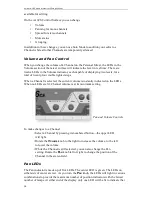
Aviom A-16 Personal Monitor Mixing System
48
49
Using a Bus Output
As an example, you could assign all the channels of the main mixer devoted to drums
to a bus. As mentioned previously, the relative mix of all the components of the drum
sound would remain the same; the levels are based on the individual channel’s level
settings. By sending all the drum channels to a bus, the entire drum kit sound can be
raised or lowered in volume from a single fader. (By using two bus outputs a stereo
drum sub-mix with panning can be created. More on this below.)
The same theory extends to the operation of the A-16. If you send the sub-mixed
drum sound in the example above from a console bus output to the A-16T Transmit-
ter, then each Personal Mixer in the system has a single channel devoted to the
drums. Each performer can control the amount of drums in his/her mix with a single
knob. The performers cannot, however, change the relative balance of the drums
that make up this mix (more snare, less cymbals, etc.). This change would need to be
made at the main mixer, and would affect the balance in all connected A-16 Mixers.
Stereo Drum Mix Example
You can extend this idea further to create a stereo drum mix. This requires that the
drums be assigned to two bus outputs, usually consecutive numbers such as 1 and 2,
3 and 4, etc. The pan (or left/right balance) from the drum kit is then set by using the
mixer’s Pan knobs. To get the floor tom into only the right speaker, for example, its
pan knob should be turned to the fully clockwise position.
The bus output idea can be combined with direct outputs as needed. This could be
useful if you wanted to have individual control over the band’s instruments, but also
be able to turn up or down all background vocals from four singers from a single
knob.
Aux Sends (Effects Sends)
An Auxiliary Send (or Aux Send for short) is typically used on a live or recording
console to send the sound from a channel into an effect device such as a reverb.
Using a dedicated set of knobs found in each channel strip, each channel can have a
different amount of the effect applied as needed.
An Aux Send does not have to be used exclusively with effects, though. You can
think of an Aux Send as another mini mixer; it functions in a similar manner to a bus
output. It is used to pass the audio signals from the console to another destination.
You can use any combination of audio sources with the A-16 to create a monitor mix.
The method for using an Aux Send to create a monitor mix is similar to that de-
scribed for using a bus output. Most consoles have from two to eight Aux Sends. So,
the number of independent audio signals that can be sent to the A-16T Transmitter via
Aux Sends will depend upon the design of the mixing console you are using.
















































